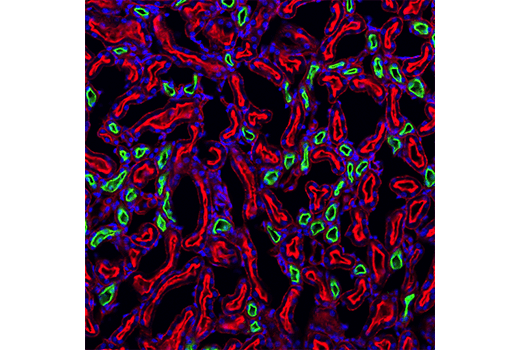IF-F
M
Endogenous
Rabbit IgG
#Q13621
6557
Product Information
Product Usage Information
| Application | Dilution |
|---|---|
| Immunofluorescence (Frozen) | 1:400 |
Storage
Specificity / Sensitivity
Species Reactivity:
Mouse
Species predicted to react based on 100% sequence homology
The antigen sequence used to produce this antibody shares
100% sequence homology with the species listed here, but
reactivity has not been tested or confirmed to work by CST.
Use of this product with these species is not covered under
our
Product Performance Guarantee.
Human
Source / Purification
Monoclonal antibody is produced by immunizing animals with a synthetic peptide corresponding to residues near the amino terminus of human NKCC2 protein.
Background
The Na-K-2Cl cotransporter (NKCC2) is a sodium-potassium-chloride cotransporter. It is mainly expressed on the luminal membrane of renal epithelial cells of the thick ascending limb of Henle's loop (TALH) and mediates the majority of NaCl resorption and concentration of urine (1,2). NKCC2 is the target for several diuretic drugs, such as bumetanide, and is involved in the pathogenesis of hypertension (3,4). Mutations in the NKCC2-encoding gene, SLC12A1, causes Bartter’s syndrome, which is featured by impaired salt reabsorption in the TALH, hypokalemic metabolic alkalosis, and hypercalciuria (5,6). Recently, NKCC2 was reported to be expressed in the brain hypothalamo-neurohypophyseal system (HNS) and upregulated upon osmotic stress (7).
- Igarashi, P. et al. (1996) J Biol Chem 271, 9666-74.
- Kaplan, M.R. et al. (1996) J Clin Invest 98, 723-30.
- Markadieu, N. and Delpire, E. (2014) Pflugers Arch 466, 91-105.
- Orlov, S.N. et al. (2015) Genes Dis 2, 186-196.
- Vargas-Poussou, R. et al. (1998) Am J Hum Genet 62, 1332-40.
- Simon, D.B. et al. (1996) Nat Genet 13, 183-8.
- Konopacka, A. et al. (2015) J Neurosci 35, 5144-55.
Species Reactivity
Species reactivity is determined by testing in at least one approved application (e.g., western blot).
Applications Key
IF-F: Immunofluorescence (Frozen)
Cross-Reactivity Key
H: human M: mouse R: rat Hm: hamster Mk: monkey Vir: virus Mi: mink C: chicken Dm: D. melanogaster X: Xenopus Z: zebrafish B: bovine Dg: dog Pg: pig Sc: S. cerevisiae Ce: C. elegans Hr: horse GP: Guinea Pig Rab: rabbit All: all species expected
Trademarks and Patents
Limited Uses
Except as otherwise expressly agreed in a writing signed by a legally authorized representative of CST, the following terms apply to Products provided by CST, its affiliates or its distributors. Any Customer's terms and conditions that are in addition to, or different from, those contained herein, unless separately accepted in writing by a legally authorized representative of CST, are rejected and are of no force or effect.
Products are labeled with For Research Use Only or a similar labeling statement and have not been approved, cleared, or licensed by the FDA or other regulatory foreign or domestic entity, for any purpose. Customer shall not use any Product for any diagnostic or therapeutic purpose, or otherwise in any manner that conflicts with its labeling statement. Products sold or licensed by CST are provided for Customer as the end-user and solely for research and development uses. Any use of Product for diagnostic, prophylactic or therapeutic purposes, or any purchase of Product for resale (alone or as a component) or other commercial purpose, requires a separate license from CST. Customer shall (a) not sell, license, loan, donate or otherwise transfer or make available any Product to any third party, whether alone or in combination with other materials, or use the Products to manufacture any commercial products, (b) not copy, modify, reverse engineer, decompile, disassemble or otherwise attempt to discover the underlying structure or technology of the Products, or use the Products for the purpose of developing any products or services that would compete with CST products or services, (c) not alter or remove from the Products any trademarks, trade names, logos, patent or copyright notices or markings, (d) use the Products solely in accordance with CST Product Terms of Sale and any applicable documentation, and (e) comply with any license, terms of service or similar agreement with respect to any third party products or services used by Customer in connection with the Products.
